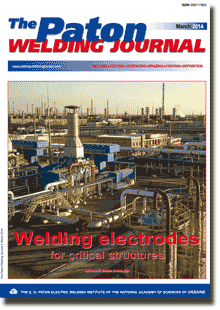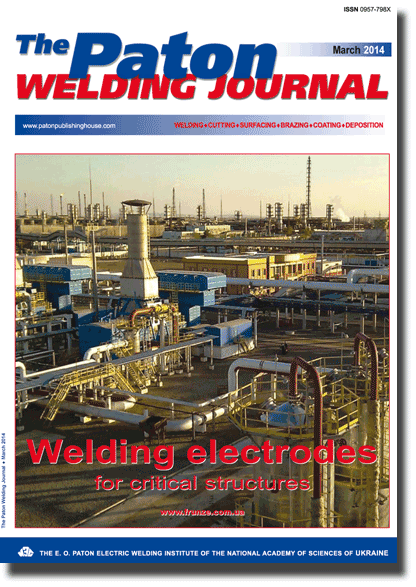| 2014 №03 (03) |
DOI of Article 10.15407/tpwj2014.03.04 |
2014 №03 (05) |

The Paton Welding Journal, 2014, #3, 21-24 pages
HIGH-POWER LASER WELDING OF AUSTENITIC STAINLESS STEEL WITH ELECTROMAGNETIC CONTROL OF WELD POOL
M. BACHMANN, V. AVILOV, A.V. GUMENYUK and M. RETHMEIER
BAM - Federal Institute for Materials Research and Testing. 87 Unter den Eichen, 12205, Berlin, Germany. E-mail: marcel.bachmann@bam.de
Abstract
Laser deep-penetration welding became a widely applied tool in industrial applications due to available laser power of 20 kW and more for the single-pass welding of steel plates of up to 20 mm thikness. Above a critical limit, liquid metal tends to drop out of the bead due to hydrostatic pressure. Laser welding, in contrast to electron beam welding technique, allows for an electromagnetic manipulation of fluid flow in the weld pool. AC electromagnetic system for compensation of the hydrostatic pressure by induced Lorentz forces in the melt was experimentally and numerically investigated for single-pass full-penetration welding of up to 20 mm thikness austenitic stainless steel plates of grade AISI 304. It was shown that the application of 200-234 mT magnetic fields at oscillation frequency of around 2.6 kHz lead to a full compensation of hydrostatic forces in the melt for plate 10-20 mm thick, respectively. Coupled fluid flow, thermal and electromagnetic finite element simulations were done with different applied magnetic flux densities and oscillation frequencies calculating for the optimal magnetic field strength to avoid melt sagging in the weld pool. The simulation results point to a lower magnetic field density needed for that purpose. The reason for that can lie in the magnetic properties of the material not being totally non-ferromagnetic. 17 Ref., 1 Table, 5 Figures.
Keywords: laser welding, high power, austenitic stainless steels, drop out of bead, control magnetic field, hydrostatic force compensation, modeling of fluid flow, calculation
Received: 10.01.14
Published: 28.03.14
References
- Avilov, V. et al. (2012) Sci. and Technol. of Weldind and Joining, 17, 128-133. https://doi.org/10.1179/1362171811Y.0000000085
- Vollertsen, F. et al. (2010) Welding in the World, 54, 62-70. https://doi.org/10.1007/BF03263489
- Ready, J.F. et al. (2001) LIA Handbook of Laser Materials Processing.
- Sanderson, A. et al. (2000) Fusion Eng. Des., 49/50, 77-87. https://doi.org/10.1016/S0920-3796(00)00407-5
- Kohyama, A. et al. (1984) J. Nucl. Mater., 122, 772-776. https://doi.org/10.1016/0022-3115(84)90697-4
- Kawahito, Y. et al. (2009) Sci. and Technol. of Welding and Joining, 14, 288-294. https://doi.org/10.1179/136217108X372531
- Shin, M. et al. (2010) Transact. of JWRI, 39, 33-38.
- Schneider, A. et al. (2013) Phys. Proc., 41, 4-11. https://doi.org/10.1016/j.phpro.2013.03.045
- Vollertsen, F. et al. (2006) J. Laser Appl., 18, 28-34. https://doi.org/10.2351/1.2164477
- Avilov, V.V. et al. (2009) Proc. of EPM (2009, Dresden, Germany).
- Avilov, V.V. et al. (2012) Sci. and Technol. of Welding and Joining, 17, 128-133. https://doi.org/10.1179/1362171811Y.0000000085
- Bachmann, M. et al. (2012) J. Phys: Appl. Phys. D, 45, 13.
- Gatzen, M. et al. (2009) Proc. of LAMP.
- Velde, O. et al. (2001) Int. J. Heat Mass Transfer, 44, 2751-2762. https://doi.org/10.1016/S0017-9310(00)00299-4
- Sahoo, P. et al. (1988) Metall. and Mat. Transact. B, 19, 483-491. https://doi.org/10.1007/BF02657748
- Mills, K.C. (2002) Recommended values of thermophysical properties for selected commercial alloys. Woodhead Publ. https://doi.org/10.1533/9781845690144
- Wilthan, B. et al. (2008) Int. J. Thermophys., 29, 434-444. https://doi.org/10.1007/s10765-007-0300-1
Suggested Citation
M. BACHMANN, V. AVILOV, A.V. GUMENYUK and M. RETHMEIER (2014) HIGH-POWER LASER WELDING OF AUSTENITIC STAINLESS STEEL WITH ELECTROMAGNETIC CONTROL OF WELD POOL. The Paton Welding J., 03, 21-24.The cost of subscription/purchase order journals or individual articles
| Journal/Currency | Annual Set | 1 issue printed |
1 issue |
one article |
| TPWJ/USD | 384 $ | 32 $ | 26 $ | 13 $ |
| TPWJ/EUR | 348 € | 29 € | 24 € | 12 € |
| TPWJ/UAH | 7200 UAH | 600 UAH | 600 UAH | 280 UAH |
| AS/UAH | 1800 UAH | 300 UAH | 300 UAH | 150 UAH |
| AS/USD | 192 $ | 32 $ | 26 $ | 13 $ |
| AS/EUR | 180 € | 30 € | 25 € | 12 € |
| SEM/UAH | 1200 UAH | 300 UAH | 300 UAH | 150 UAH |
| SEM/USD | 128 $ | 32 $ | 26 $ | 13 $ |
| SEM/EUR | 120 € | 30 € | 25 € | 12 € |
| TDNK/UAH | 1200 UAH | 300 UAH | 300 UAH | 150 UAH |
| TDNK/USD | 128 $ | 32 $ | 26 $ | 13 $ |
| TDNK/EUR | 120 € | 30 € | 25 € | 15 € |
AS = «Automatic Welding» - 6 issues per year;
TPWJ = «PATON WELDING JOURNAL» - 12 issues per year;
SEM = «Electrometallurgy Today» - 4 issues per year;
TDNK = «Technical Diagnostics and Non-Destructive Testing» - 4 issues per year.


